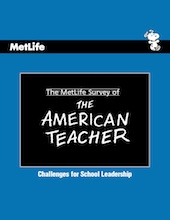Teacher-Driven Observation: Deprivatizing the Classroom

 Trent E. Kaufman, Ed.D. and Emily Dolci Grimm are principals at Education Direction, a firm focused on improving student outcomes through professional development, school transformation, and strategic planning. The principles they promote and support to help schools and districts are found their book The Transparent Teacher (Wiley, 2013).
Trent E. Kaufman, Ed.D. and Emily Dolci Grimm are principals at Education Direction, a firm focused on improving student outcomes through professional development, school transformation, and strategic planning. The principles they promote and support to help schools and districts are found their book The Transparent Teacher (Wiley, 2013).
Deprivatizing a Private Practice
By Trent Kaufman & Emily Dolci Grimm
As former teachers, we have decades of combined experience in the classroom. We’ve taught in small schools, large schools, urban schools, rural schools, private schools, public schools, and parochial schools. You name it, we taught in it. You can imagine that our experiences have been quite diverse.
With all the differences we’ve noted in our individual careers, there are some constants. We were underpaid and overworked and we loved every minute of it (well—almost every minute of it). We agree that above all else, there is one thing about teaching that stands out (rather glaringly) as something we didn’t like: the isolation.
Every teacher is an island
In education there is some truth in this statement, and it’s not always a good thing. Sure, there are some positives associated with the independence afforded to those in the teaching profession. Autonomy, individuality, freedom. But there are dangers as well.

That’s not where it ends though. Professional isolation also leads to decreased job satisfaction. In a recent survey of educators conducted by MetLife, teachers who reported being dissatisfied with their jobs were more likely to be located in schools that had declines in time for teacher collaboration. With over 30% of new teachers leaving the profession during their first five years, the role that professional isolation plays in teacher attrition rates is worthy of attention.
Come on in
Because we experienced this isolation ourselves (and felt the same dissatisfaction that so many other teachers feel when faced with going it alone), we became interested in ways to break down the siloed nature of schools. We recognized that doing so would require teachers to go deeper than the collaborative structures (including common planning time) that have gained traction in the last decade to include opening our doors to our peers and inviting them to come on in.
Opening our classrooms to observation by other professionals presents some genuine challenges. For most of us, our experiences with traditional observation models have been evaluative in nature. Not only do these traditional observation structures serve the observer more than the observed teacher, rarely do they yield data that can immediately inform teaching and improve student learning.
As a result of these kinds of experiences, we’ve grown so accustomed to making observation and evaluation one and the same that we’ve become uncomfortable with the idea of having anyone observe our teaching. In fact, when we ask teachers about peer observations, we typically hear the same response: I don’t feel comfortable having my peers observe my teaching.
A fundamental change in observation structures in necessary if we hope to increase teachers’ comfort level and promote the kinds of collegial observations that can break down professional isolation and promote improvements in teaching and learning.
Introducing Teacher-Driven Observation

In TDO, the lead teacher drives the process from start to finish, beginning with the identification of an area of focus, which she articulates through a question. He may ask, “How are the opportunities I create for students to engage in guided practice promoting their ability to cite specific textual evidence?” or “To what extent are the questions I ask students promoting their thinking and reflection, and deepening understanding of content?” She then invites her peers to collect data relevant to this area of focus (which she explains in a pre-observation meeting).
Following the observation, the lead teacher facilitates a structured post-observation “debrief,” during which she thoughtfully considers the data and commits to action steps to improve teaching and learning in her classroom. At the end of the process, she steps away with data she could not have collected on her own—data that will lead to relevant changes in instruction and student learning.
If this approach to observation seems different from what you’ve experienced in the past, that’s because it is. Teacher-Driven Observation puts the observed teacher at the center of the learning process, promoting increased clarity about her teaching practice, learners’ specific needs, and what she can do to improve teaching and learning. TDO is different because it is a process that equips a teacher to call on his peers to support him in improving his craft.
Why TDO works
Opening our classroom doors through Teacher-Driven Observation reduces professional isolation because the process provides a context for dialogue about the core of our work: teaching and learning. This authentic collaboration is grounded in what occurs in our classrooms, with our students, and with our content.
Teacher-Driven Observation creates a space for professional learning that incorporates practice and refinement, while at the same time building professional dialogue and collegial collaboration. In doing so, it is particularly effective in reducing professional isolation for the following reasons:
• TDO is low-threat. Unlike traditional observation processes, TDO does not require a high level of comfort for all participants. It only requires the vulnerability of the lead (observed) teacher, who creates a tone of learning and improvement by grounding the observation in her own classroom.
• TDO highlights the value of the observers. The observing colleagues are an essential resource in TDO. Their data collection and post-observation conversations provide the lead teacher with valuable data that she could not have collected on her own. In doing so, it builds comfort and familiarity with the process for all involved.
• TDO keeps the main thing the main thing. The data collected in TDO provides a foundation on which to examine the relationship between teaching and learning—the heart of the profession. Through focused data collection and analysis, attention is on the relationship between teaching and learning—not on evaluation of an individual.
• TDO engagement happens organically. When observers enter into the lead teacher’s room to collect data, the process is demystified. Once they see how valuable (and non-threatening) the process is, they’re likely to open the doors of their classrooms as well.
Collecting data via the Teacher Driven Observation process breaks down the walls of isolation that exist in schools. Through the reduction in isolation, teachers are better able to focus on the relationship between teaching and learning and to practice and refine their instruction in the context in which they work each day.
By decreasing professional isolation, participating teachers have increased job satisfaction (research tells us again and again that teachers who collaborate with their peers are happier in their positions and more likely to stay in the profession) and the data they need to teach more effectively. Through this process, TDO improves teaching and student learning—one open classroom at a time.
References
Carroll, T. G. & Foster, E. (2010). Who will teach? Experience matters. Washington, DC: National Commission on Teaching and America’s Future.
Eaker, R., DuFour, R., & DuFour, R. (2002). Getting started: Reculturing schools to become professional learning communities. Bloomington, IN: National Educational Service.
MetLife, Inc. (2013). The MetLife survey of the American teacher: Challenges for school leadership. New York, NY: MetLife.




































